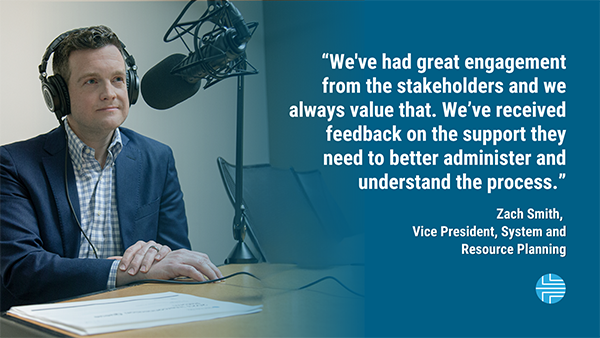Enhancing NYISO’s Interconnection Queue Through Process Reforms and Workforce Investments

Interconnecting new generation and transmission projects at the scale necessary to meet the goals set forth in New York’s Climate Leadership and Community Protection Act is a challenging task. According to our 2021-2040 System & Resource Outlook, at least 111 gigawatts of renewable resources will need to be online by 2040. That’s three times larger than the 37.4 gigawatts in generating capacity that exists on the grid today. Additionally, more transmission will be required to move that energy from areas of generation to load pockets. To meet these challenges, we are taking several steps to improve the interconnection process.
Reforming The Process
As previously detailed in our 2023 interconnection whitepaper, important process reforms were implemented in 2022. Those changes occurred in two key areas: System Reliability Impact Study (SRIS) timeline enhancement, and improved transparency of project progress and status for all interested parties in the SRIS process. Specifically, after a thorough and collaborative process review with stakeholders, certain elements of the SRIS process that were duplicative or unnecessary were eliminated. We implemented these revisions for 35 projects already in the queue to expedite the current process for each and will apply these new rules to all projects going forward, creating a permanent process enhancement. More recently, we held numerous forums and focus groups with developers, utilities, the State Public Service Commission, the New York State Energy Research & Development Authority, and other stakeholders, to receive feedback and gain insight on further improvements that are now under consideration. For example, we are exploring ways to improve the management of requested changes from developers for projects that are in between the study stages as those requests add significant time to the process.
enhancement, and improved transparency of project progress and status for all interested parties in the SRIS process. Specifically, after a thorough and collaborative process review with stakeholders, certain elements of the SRIS process that were duplicative or unnecessary were eliminated. We implemented these revisions for 35 projects already in the queue to expedite the current process for each and will apply these new rules to all projects going forward, creating a permanent process enhancement. More recently, we held numerous forums and focus groups with developers, utilities, the State Public Service Commission, the New York State Energy Research & Development Authority, and other stakeholders, to receive feedback and gain insight on further improvements that are now under consideration. For example, we are exploring ways to improve the management of requested changes from developers for projects that are in between the study stages as those requests add significant time to the process.
Adding to Our Team
Working together across several departments, our team of independent experts help maintain system reliability every minute of every day. As the interconnection queue has grown in recent years, so has the number of professionals working in two critical departments: Planning and Stakeholder Services. Since 2018, we’ve added 10 professionals to our Planning team and 3 professionals to our Stakeholder Services team. These dedicated individuals are working diligently to improve every interaction with developers during the interconnection process. As more clean energy projects and large industrial loads seek to connect to the grid in the coming years, we anticipate that more engineers, project managers, and customer service agents will be needed to address the growing queue.
Improving Existing Technologies
Teams across our organization leverage technology to maintain grid reliability every day. Our Stakeholder Services team has applied this tech-centric focus to recent and ongoing improvements to our interconnection portal. This online tool is designed to help developers in the queue access important project information and process guides. Recent improvements to the portal include streamlined inquiry submissions and on-demand access to common interconnection questions. We’re also in the process of engaging with customer focus groups to discuss and develop additional portal functions with the expectation that those improvements will be implemented in early 2024.

Pursuing Progress
While we’ve made important improvements in our process and investments in our people and technology, our entire organization is committed to doing much more to enhance the interconnection progress. While 2030 and 2040 sound like distant dates, time is of the essence when it comes to delivering the grid of the future. Finding greater process efficiencies while maintaining system reliability will require more collaboration, communication, and commitment from all parties.
